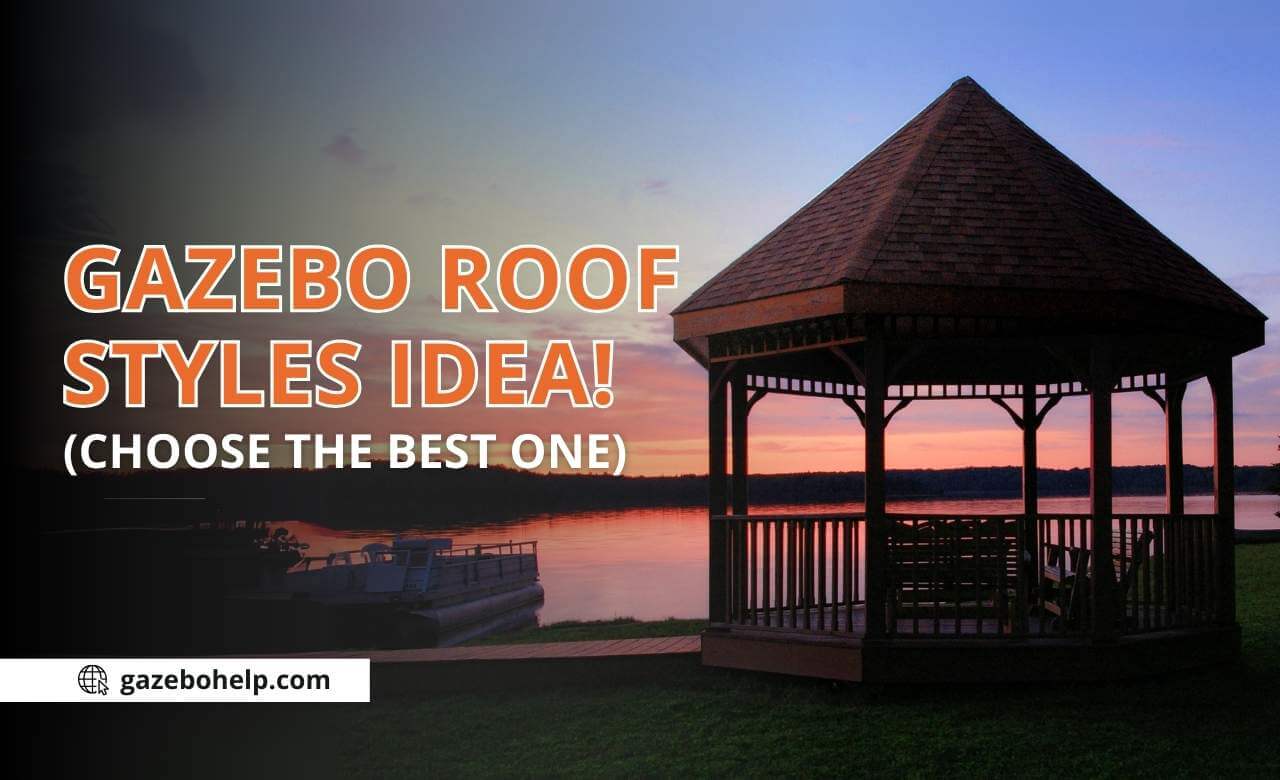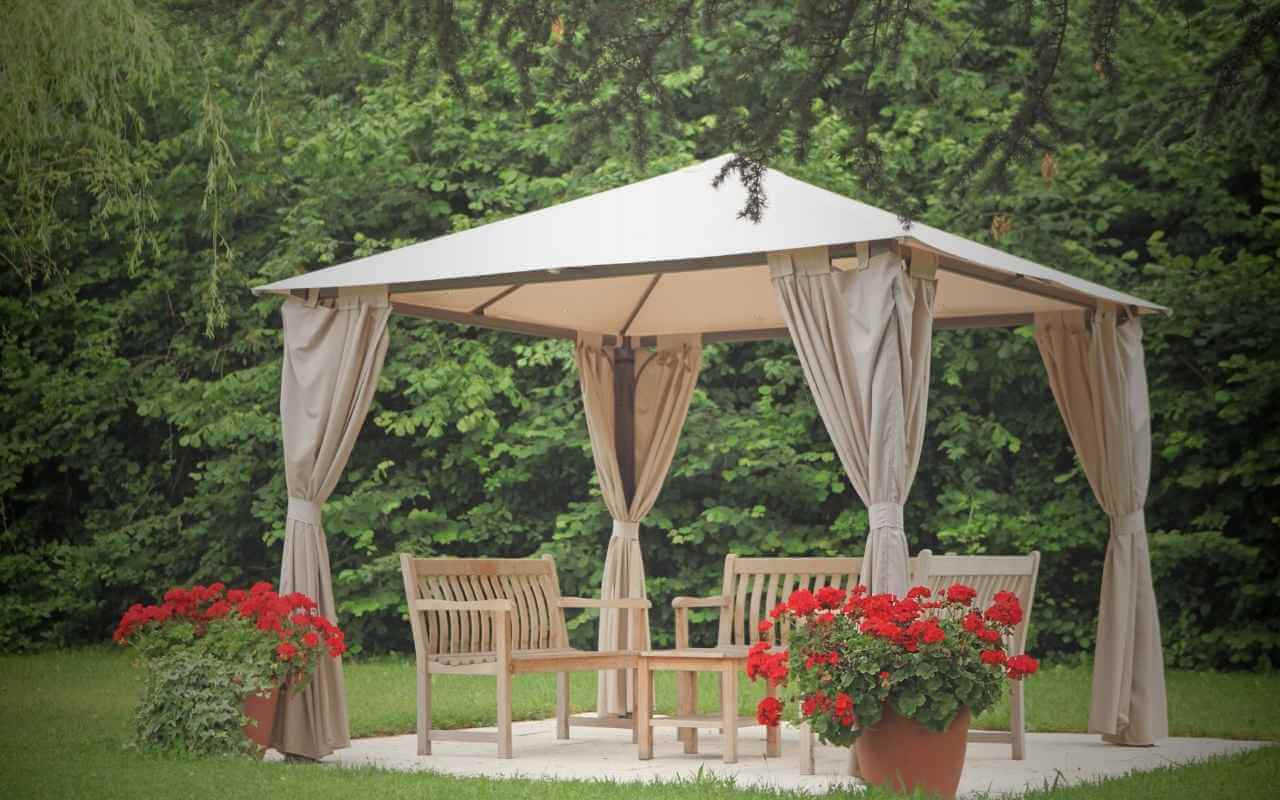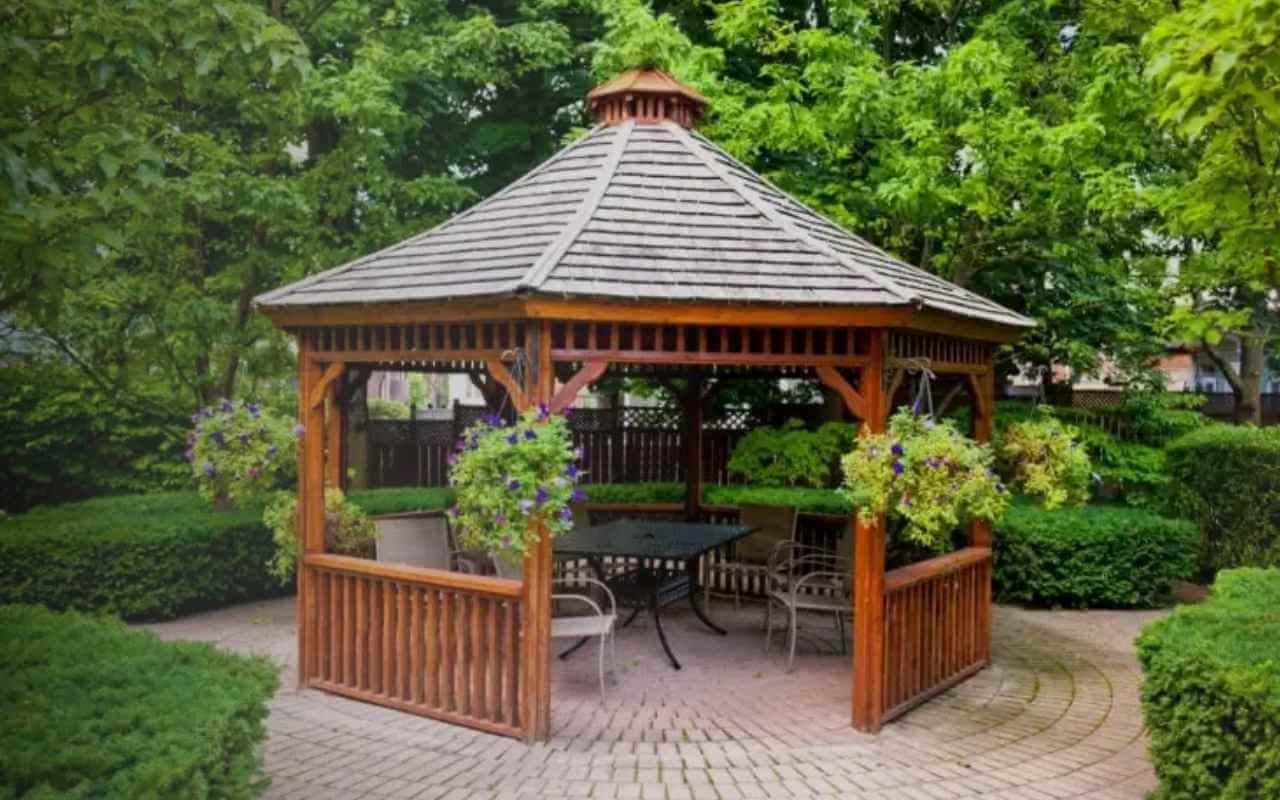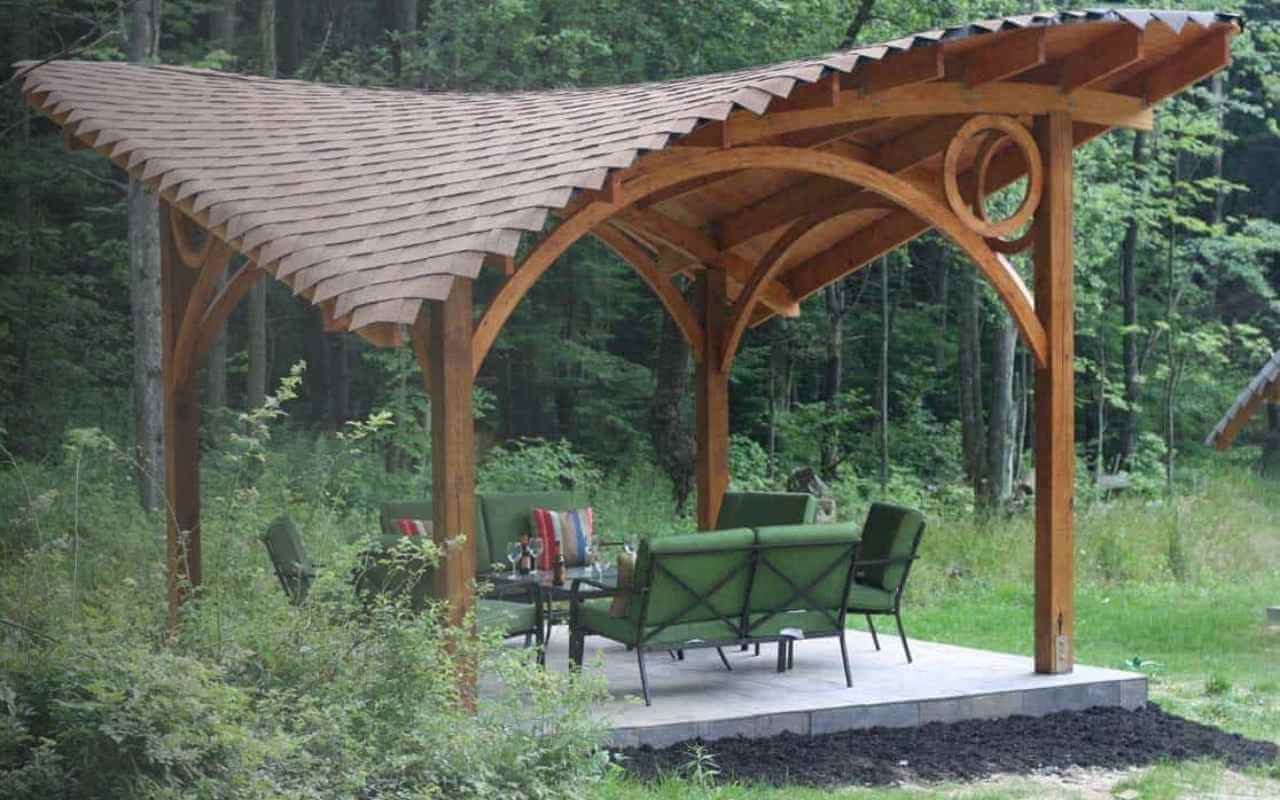Phone:
(701)814-6992
Physical address:
6296 Donnelly Plaza
Ratkeville, Bahamas.

The roof is one of the most crucial components of a gazebo. It serves two primary purposes: providing protection from bad weather conditions and improving overall aesthetic appeal of your outdoor space.
In case you are considering building a new gazebo in your garden or renovating an existing one in your backyard, choosing the right roof style is a vital decision that deserves careful thought.
Here will help you through popular gazebo roof styles, detailing their key features, benefits, and ideal use cases:

A hip roof is a popular choice for gazebos due to its stability and classic aesthetic. This design features all sides sloping downwards, which not only adds to its visual appeal but also makes better its ability to withstand harsh weather conditions. The four slopes effectively channel rainwater and snow away from the structure, making it a durable option.
| Pros | Cons |
| Provides excellent stability and wind resistance | Requires skilled labor for proper construction |
| Offers a classic, elegant look | More complex and expensive to construct |
| Good for shedding water and snow | Less attic space compared to some other styles |

The gable roof is characterized by its triangular shape, with two sloping sides that meet at a ridge. This classic design is both functional and aesthetically pleasing, making it a popular choice for gazebos.
| Pros | Cons |
| Simple and cost-effective to construct | Less stable in high-wind areas |
| Excellent for water and snow runoff | Can look overly simple on larger structures |
| Provides more interior space and better ventilation |

The pyramid roof is distinguished by its four sloping sides that converge at a single peak, forming a pyramid-like structure. This design is both unique and functional, making it an excellent choice for various outdoor settings.
| Pros | Cons |
| Versatile aesthetics for various styles | Higher construction costs |
| Improved ventilation for coolness | More maintenance required |
| Ideal for overhead lighting | Snow accumulation risk |
| Unique shape adds visual appeal | Limited storage usability |
| May increase property value | Can dominate landscape design |

A curved roof features smooth, rounded lines, adding a modern touch to your gazebo. This design enhances visual appeal and blends well with nature. Curved roofs are effective for water runoff, reducing the risk of leaks.
| Pros | Cons |
| Offers a unique and modern appearance | Higher construction costs |
| Can provide excellent water runoff | Requires specialized installation skills |
| Creates a bright and airy space | Limited material options for design |
| Softens the gazebo’s appearance |

A dome roof has a rounded, hemispherical shape that gives your gazebo an elegant and spacious feel. This style not only improves aesthetics but also provides excellent water drainage, making it a practical choice for various weather conditions.
Dome roofs can be constructed from materials like metal, shingles, or fiberglass, making sure of durability while adding a unique architectural flair to your outdoor space.
| Pros | Cons |
| Durable against various weather conditions | Higher construction costs |
| Excellent water drainage | Requires expert craftsmanship |
| Elegant and unique design | Complex installation process |
| Provides spacious interior | May not suit all architectural styles |
| Limited ventilation options |

A pagoda roof features a distinctive tiered design that adds a touch of elegance and cultural flair to your gazebo. This style is characterized by its upward-curving eaves and multiple levels, creating a striking visual impact.
| Pros | Cons |
| Offers a unique and modern appearance | Complex construction process |
| Good water runoff | Higher maintenance needs |
| Provides ventilation | Limited space for furniture |
| Sturdy construction | May require additional support structures |

A flat roof is a simple and modern design that offers a clean, minimalist look for your gazebo. This style is characterized by its level surface, which allows for easy access and versatile use of the roof space. Flat roofs are often used for urban settings, providing an excellent space for solar panels, rooftop gardens, or outdoor furniture.
| Pros | Cons |
| Easy to construct and install | Poor drainage can lead to water pooling |
| Provides usable roof space | Limited aesthetic appeal |
| Modern and sleek appearance | Can be less durable in heavy weather |
| Low maintenance requirements | Requires regular inspections and upkeep |
| Cost-effective design |

A hexagonal roof features six sides, creating a unique and visually appealing design for your gazebo. This style adds a touch of elegance and sophistication while maximizing the interior space.
| Pros | Cons |
| Distinctive and attractive design | More complex to construct |
| Increases interior space and headroom | Higher material costs due to unique shape |
| Offers better wind resistance | Need skillful company for installation |
| Can accommodate multiple entry points | May not fit traditional garden aesthetics |
| Versatile for various settings and themes | Can be challenging to find compatible furniture |
| Improve natural light with ample windows | May have Limited design options |

An octagonal roof consists of eight sides, providing a striking and spacious design for your gazebo. This roof style not only enhances the visual appeal of your outdoor space but also offers increased stability and interior room. The unique shape makes it a great choice for those looking to make a bold statement in their gardens or yards.
| Pros | Cons |
| Eye-catching and unique appearance | Limited furniture options due to shape |
| Improved wind resistance compared to flat roofs | More complex and costly to build |
| Spacious interior with enhanced headroom | Requires skilled labor for proper installation |
| Excellent drainage with a central peak | May require additional support for heavy snow loads |
| Allows for multiple entry points | Can appear out of place in traditional settings |
| Versatile design suitable for various outdoor themes | |
| Can be fitted with windows for added natural light |

A butterfly roof features two sloping sides that meet in the middle, resembling the wings of a butterfly. This design creates a unique architectural look while also allowing for effective rainwater collection.
| Pros | Cons |
| Modern and stylish appearance | May require more maintenance to manage water drainage |
| Effective rainwater collection for drainage or irrigation | Can be less stable in high winds compared to other roof types |
| Increased natural light with higher central peaks | More challenging to insulate, leading to temperature fluctuations |
| Promotes good airflow and ventilation | Limited headroom at the edges may restrict tall furniture options |

A combination roof blends different roof styles, such as gable, hip, or flat roofs, to create a unique and functional design. This versatile approach allows for enhanced aesthetics and can help optimize space and ventilation in your gazebo.
| Pros | Cons |
| Offers a unique and customized appearance | Requires careful design planning to avoid water drainage issues |
| Combines the advantages of different roof styles | This may involve more maintenance due to multiple roof types |
| Improve ventilation and airflow | Can be more complex and expensive to construct |
| Provides increased structural stability | This can complicate the installation of lighting and insulation |
| Aesthetic mismatch if not designed cohesively | |
| Potential for increased repair costs if one section needs attention |

A clerestory roof features a section of the roof that rises above adjacent rooftops, incorporating windows that allow natural light to flood into the space below. This design not only upgrades the aesthetics of your gazebo but also improves ventilation and creates a brighter, more inviting atmosphere.
| Pros | Cons |
| Improved ventilation reduces heat buildup | Can be more expensive to construct |
| Abundant natural light enhances the ambiance | May require specialized expertise for the installation |
| Maintains privacy while allowing light in | Potential for increased heat gain in summer |
| Adds architectural interest and uniqueness | Higher maintenance due to window cleaning and repairs |
| Energy-efficient by reducing reliance on artificial lighting | Risk of leaks if not properly sealed |

An arched roof features a curved structure that adds elegance and style to your gazebo. This design provides a spacious and airy feel while allowing for effective water drainage. The arched shape is not only visually appealing but also structurally strong, making it a popular choice for outdoor structures.
| Pros | Cons |
| Aesthetic appeal adds elegance to the gazebo | Can be more challenging and costly to construct |
| Improves Structural strength and durability | Limited design options compared to flat roofs |
| Also, Improved water drainage reduces pooling | May require specialized materials or techniques |
| Creates a spacious, open interior feel | Potential for heat buildup if not properly ventilated |
Here are a few Pro tips that will help you with a good gazebo roofing style:
Pick a roof style that looks good with your home and garden. For a classic look, try a dome or hip roof. For a modern vibe, go with a flat or skillion roof.
Choose a roof that handles your local weather. In rainy or snowy places, a gable or pyramid roof is good for letting the water run off. In windy areas, a hip or pyramid roof is more stable.
If you want lots of natural light and fresh air, think about a butterfly or clerestory roof with windows. These designs make the inside of the gazebo brighter and cooler.
Consider how easy it is to take care of the roof. Sloped roofs like gable or hip designs are easier to maintain because they let water and leaves slide off. Flat roofs might need more cleaning.
Make sure the roof you choose fits your budget. Fancy designs like tiered or pagoda roofs can be more expensive. Simple styles like flat or single-slope roofs usually cost less.
Picking the right roof for your gazebo is important. The roof will make your gazebo look really nice. You can choose a fancy curved roof or a simple pointed roof. You can even pick a cool pagoda-style roof.
Decorating the roof with trim or using special materials like copper will make it stand out. Make sure to pick a roof color that goes with your house. The perfect gazebo roof will keep you comfortable while hanging out outside.